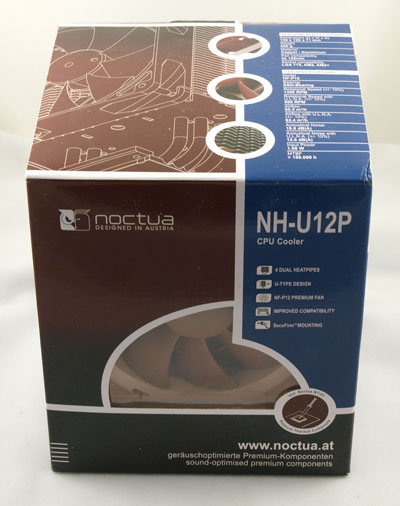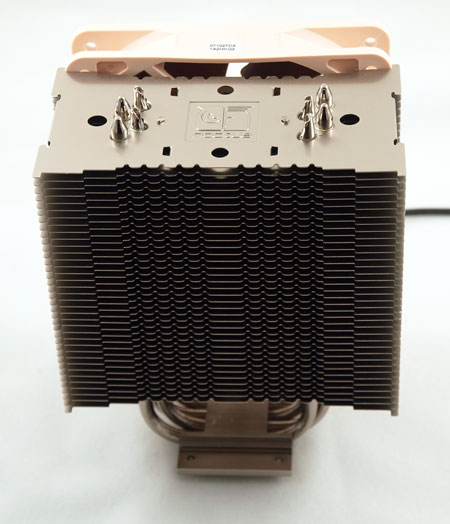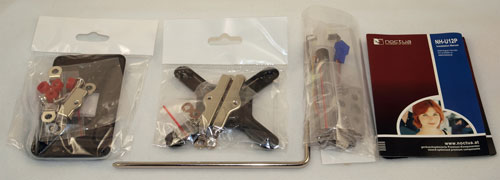Noctua NH-U12P: Top Performance AND Silence
by Wesley Fink on March 20, 2008 8:00 PM EST- Posted in
- Cases/Cooling/PSUs
The Noctua NH-U12P Cooler
Noctua has made some inroads in to the US cooler market in the past few months, but Noctua is still not a well-known brand in the US market. You won't find Noctua sold at the large US etailers like Newegg, ZipZoomFly, or mWave. You can find Noctua coolers at specialty computer enthusiast shops like Frozen CPU or Xoxide. The Noctua NH-U12P kit retails for around $69, but we have seen it selling for lower prices at a few etailers. The kit includes the Noctua NH-U12F fan, which retails for $21 by itself.

The Noctua NH-U12F continues the Noctua trademark brown and blue packaging. It seems that everything Noctua comes in packaging with variations on this corporate color scheme.

Inside the dark brown box, you will find two inner boxes with a heatpipe tower that is very reminiscent of the Thermalright Ultra-120 design and a package of mount kits and accessories. Noctua has been refining the basic design of this 120mm heatpipe tower for some time, but this heatsink is identical to the one reviewed in the NH-U12F review last year. There are fan wire channels that allow mounting of both front and rear 120mm fans on the Noctua if you choose that configuration.

You will also find an exceptionally well-protected heatsink, along with everything you need to mount the heatsink on an Intel Socket 775, or an AMD AM2/AM2+. Noctua is no longer including the AMD K8 (754/939/940) mount accessories that were part of earlier kits. The kit even includes four fan clips so there is enough hardware to mount both a front and rear fan in a push-pull configuration.

As mentioned earlier, the $21 retail S12 fan is also included and it is really the only difference from the earlier NH-U12F kit. Also included are L.N.A (Low-Noise) and U.L.N.A. (Ultra-Low Noise) adapters that fit between the fan plug and the board, which are useful for those who want to run slower speed and the lowest noise.
The included accessories abound with thoughtful little touches. Noctua includes a screwdriver that actually fits in the holes of the cooler fins to allow cooler mounting in some of the mount variations. The two included pairs of fan wire clips practically invite the buyer to try a push-pull fan setup. A clearly written installation manual with sections for both the Intel 775 and the AMD AM2/AM2+ is also in the package. Overall, the clear parts identification, abundance of mount options, and included extras make the Noctua one of the most flexible coolers we have worked with right out of the box.
Specifications
The 120mm fan is new and the only thing unique in this kit. The heatsink is the same one seen in the NH-U12F and other top Noctua kits, but it has seen further refinement since our NH-U12F review. The copper is nickel-plated in this incarnation and size and weight have minor revisions. With a design very similar to the top Thermalright coolers, it will be interesting to see if the new high-performance fan pushes this combo into the top tier of cooler performance.
| Noctua NH-U12P Heatsink | |
| Dimensions | 95(L) X 126(W) X 158H)mm (including fan) |
| Weight | 600g (excluding fan); 770g with fan |
| Material | Copper and Aluminum with soldered joints and nickel plating |
| Fan Configuration | Supports up to two 120mm fans of any thickness with open mounting posts |
| Noctua Fan | |
| Model | Noctua NF-P12 (included, but also sold separately) |
| Fan Size | 120mm x 120mm x 25mm |
| Bearing Type | SSO Bearing |
| Noise Level | 19.8dbA/16.9dbA/12.6dbA (stock/LNA/ULNA) |
| Speed | 1300/1100/900 rpm (stock/LNA/ULNA) |
| Air Flow |
92.3/78.5/63.4 cubic meters/hour (stock/LNA/ULNA)
(54.3/46.2/37.3 cubic feet/minute) |
| Fan Bearing | SSO Bearing |
| Blade Geometry | Nine-Blade Design with Vortex Control Notches |
| Input Power | 1.08W at 0.12A Input Current |
| Voltage | 12V |
| Fan Life | >150,000 hrs (vs. 50,000 hrs for ball bearing) |
| Weight | 170g (fan only) |
The vortex control notches promise high performance and the new bearings promise long fan life. Noctua has so much confidence in the new fan design that they provide a six-year warranty with the new fan. While the fan price of $21 may seem high at first, the six-year warranty promises a much longer useful life than most competing fans.










51 Comments
View All Comments
7Enigma - Wednesday, April 9, 2008 - link
ZEROtherm Nirvana NV120 120mm 2-ball UFO Bearing / Transparent CPU Cooler - Retail ($36.00 after rebate)With the $10 rebate its the same price as the Arctic Cooler Freezer 7 Pro
http://www.newegg.com/Product/Product.aspx?Item=N8...">http://www.newegg.com/Product/Product.aspx?Item=N8...
coolsmith - Thursday, March 27, 2008 - link
Just to complement my previous post on this fanI should have mentioned that I found leaving the speed setting to
medium gave the best result for noise verse speed.
This fan does cost a little bit more than the others but it should
last a lot longer.
coolsmith - Thursday, March 27, 2008 - link
I installed one as a rear case fan and I'd have to say they are indeedquiet and do a good job.
But I'd have to agree with most the color is a bit of a turn off, but
since mine is inside the case a really don't mind.
A well built fan but crappy color .
If they were to change the color they would probably sell alot
more of them, for sure.
7Enigma - Tuesday, March 25, 2008 - link
I have a bit of a problem with the review and conclusion. This heatsink/fan looks to be good, the problem is it seems to be just as good as the:Nirvana, Ultra 120, Infinity, Ninja, Ultima90, Tuniq Tower
all of which are less expensive. By using these "real world results" the test fails to really tell us what is different about the new design of the fan!
I want to know that at 1/4, 1/2, or full voltage this fan either:
a. is quieter (better design/aerodynamics)
b. pushes more air (more efficient/ better design)
It's great to show in your testbed that it works !great!, the problem is its not really that helpful to a potential buyer wondering WHY its so great.
During video card reviews this site constantly takes heat from the H-site (we'll remain nameless :) ), on your reviews not being "real-world", and I've always sided with you guys because you are scientifically limiting your variables to give a good indictation of which card is better. But now I feel these heatsink/fan reviews are somewhat falling into the same trap of that other site in providing data points that are not accurate; just rather you can say that the Noctua, Alpine, Freezer 7, Nirvana, Ultra 120 Extreme, Ultima90, and Kama Cross are all below your artificial noise floor. It's the equivalent of testing all of the new video cards at 1024X768 resolution with a 60fps framerate cap in Quake3, they are all going to look like winners!
What a competent review needs to aim for is removing all variable outside of what is being tested. When your testing video cards, make sure the cpu isn't the bottleneck, when your measuring hard drives, make sure you don't have a mobo/driver issue, and when your measuring heatsinks and fans, make sure that if your not actually checking their stated cfm's for accuracy, at least you are measuring the noise level of the fan.
My case sits under my desk doing its thing out of sight. If I'm going to throw down $20 for a FAN, a freaking FAN man!, I want to know those pretty shaped blades are actually doing something measurably different and beneficial than a $5-10 one.
Wesley Fink - Tuesday, March 25, 2008 - link
Our noise floor is limited by the Power Supply, which was selected because it is one of the quietest variable fan speed models we could find. That noise level is equivalent to a suburban bedroom at night as pointed out in every recent review. Real world is NOT running a power supply in one room so you can measure noise levels lower than you will ever see in a real system limited by power supply noise. If you want those measurements there are websites devoted to those esoteric numbers and you can find what you seek.For our part we did measure the single fan at high speed and the cululative two fans at highest speed in a system with a quiet variable speed power supply and a fanless video card. Both measurements were below our noise floor. All lower speeds with the shunts will be below that and are not measurable in our system.
The sad fact about the current low noise obsession is that readers see so many low numbers they have lost perspective on what the numbers actually mean. Those screaming for measurements of 10 to 20 dbA should Google a few articles on noise measurement to see what those numbers actually measure and the laboratory needed to accurately measure those low noise levels.
130 dBA Loud hand clapping at 1 m distance (maximum level)
120 dBA Whistle at 1 m distance, test run of a jet at 15 m distance
Threshold of pain, above this fast-acting hearing damage in short action is possible
115 dBA Take-off sound of planes at 10 m distance
110 dBA Siren at 10 m distance, frequent sound level in discotheques and close
to loudspeakers at rock concerts, violin close to the ear of an orchestra
musicians (maximum level)
105 dBA Chain saw at 1 m distance, banging car door at 1 m distance (maximum level),
racing car at 40 m distance, possible level with music head phones
100 dBA Frequent level with music via head phones, jack hammer at 10 m distance
95 dBA Loud crying, hand circular saw at 1 m distance
90 dBA Angle grinder outside at 1 m distance
Over a duration of 40 hours a week hearing damage is possible
85 dBA 2-stroke chain-saw at 10 m distance, loud WC flush at 1 m distance
80 dBA Very loud traffic noise of passing lorries at 7.5 m distance,
high traffic on an expressway at 25 m distance
75 dBA Passing car at 7.5 m distance, un-silenced wood shredder at 10 m distance
70 Small car at 30 mph; 3 meters from a vacuum cleaner.
65 1 meter from normal conversation. Busy office. About half the people in a large sample will have difficulty sleeping.
55 Recommended upper limit for large open offices, restaurants, gymnasiums, swimming pools.
45 Recommended upper limit for homes, hotels, laboratories, libraries, private offices, court rooms.
40 Quiet office. Recommended upper limit for classrooms, churches, motion picture theaters (without the film soundtrack).
35 Quiet bedroom.
25 Countryside on windless day, away from traffic. Sound of breathing at 1m distance.
7Enigma - Wednesday, April 9, 2008 - link
So then please tell me how this fan is better than any $5 fan? If it doesn't matter if its below the noise floor, I don't know how you can come to the conclusion that its a good product? To me if it performs the same as a $5 fan its overpriced right?marine73 - Tuesday, March 25, 2008 - link
For those howling for readings in the 10-20dB range the world must be an incredibly noisy place. Ants on the sidewalk sounding like stormtroopers, ducks on a pond sounding like top fuel hydros...not sure how they can even enter a room with a PC running.vajm1234 - Sunday, March 23, 2008 - link
is there ny possibility of reviewin the new scythe zipang n all.Thorsson - Saturday, March 22, 2008 - link
The fan shown in the picture on the Installation page doesn't look like the new one to me...Wesley Fink - Sunday, March 23, 2008 - link
They are both the new fans. Due to the curvature and sweep of the blades it is more difficult to distinguish the notches from the front view. That is why all the "notch" pictures are from the rear of the fan.